Spring care for a pear in the country after winter
The pear is the second most popular fruit tree (after the apple tree) in our gardens. And it is no coincidence, because this plant is much less unpretentious and requires some care from its owner, especially in spring, when it wakes up after hibernation.
Below you will find useful tips and basic rules for caring for a pear in the spring.
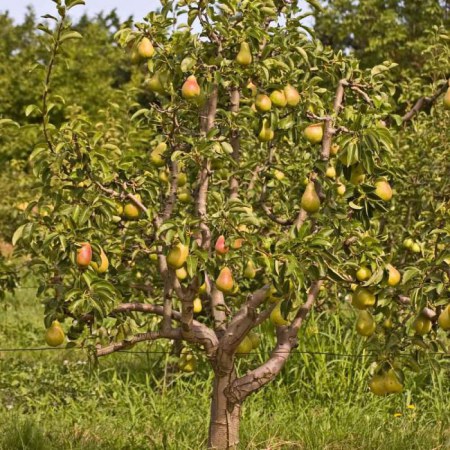
Content
The main activities for spring pear care
The gardener's spring work schedule in the orchard includes several basic agrotechnical measures that will help pear trees grow actively, develop throughout the growing season, in order to please you with a bountiful harvest at the end.
Removing protective cover from young seedlings
When the weather is stable and warm, the snow melts and the soil completely thaws (freezes), it will be possible to remove the protective non-woven tapes (or similar devices), which were wrapped around the lower part of the trunk in autumn to protect it from rodents (mice and hares), as well as from sunburn (instead of whitewashing).
However! There is no need to rush if you have used the correct breathable (non-woven) fabric - nothing will stick.
If you remove the tape ahead of time, then the delicate bark of young seedlings can get sunburn (crack).
Whitewash
Whitewashing trees in early spring (in February-March) is carried out only if for some reason they did not do it in the fall (Although it was necessary!), Or the whitewash was washed off or badly peeled off over the winter. Therefore, spring whitewashing is also called repeated or renewing.
Remember once and for all: there is no practical point in whitening trees in May, only aesthetic (and very dubious).
By the way! The site has a detailed article about when and how to whitewash trees in the garden.
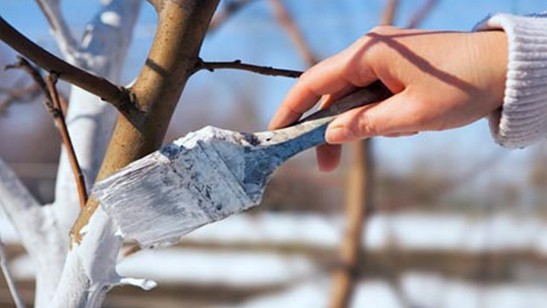
Pruning
It should not be a discovery for you that it is spring that is the optimal time for pruning all fruit trees, including pears, as well as apple trees, peaches, apricots and etc.
So, in the spring, first of all, sanitary pruning, i.e. you need to remove any broken and dry branches that have not survived the winter. And then:
- Continue form young seedlings in order to create a crown of the correct shape.
- For adults (old) and long-term fruiting pear trees, exercise thinning, stimulating and rejuvenating pruning.
Note! The site already has detailed material about how to prune an old pear and shape a young one.
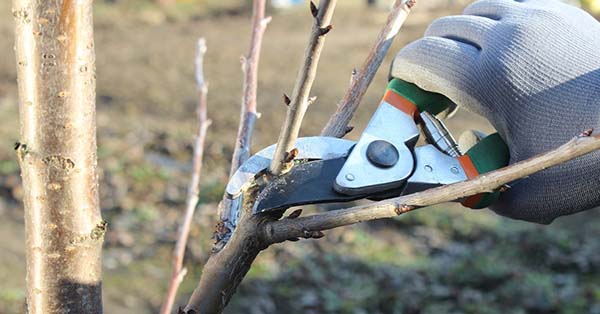
Video: how to properly prune a pear in spring
Bending branches
When growing a pear, many novice gardeners do not pay attention to which direction the branches grow. However, if the branches continue to grow vertically upwards, then the pear will begin to bear fruit only 6-7 years after planting.
Accordingly, if you want fruiting to come much earlier, you need to carry out an independent bending branches, bringing them to the maximum horizontal position (from 60 to 90 degrees).
The fact is that it is at this angle of inclination that the branches begin to lay fruit buds.
And this procedure also slows down the growth of the tree.
However! Tops will be trampled from horizontal branches, which will need to be promptly removed (removed) during the summer.
When and how to do it?
In the spring, when the buds begin to swell, you need to pull the branches down and fasten (tie) them with twine (linen thread) to the main tree trunk (not the best option) or to pegs in the ground (optimal).
Why is it better to drive small pegs into the ground and tie to them?
Over time, the rope will begin to pinch the trunk of the tree, and if you do not untie it in time, it can simply press (grow) into the trunk.
Of course, there is more fuss with pegs, but it is much safer and looks much neater.
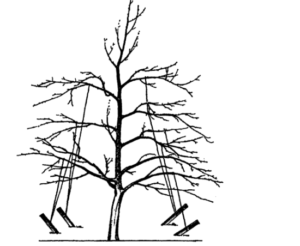
Important! And don't forget to take off your ropes in late autumn. During the growing season, the branch will form the required shape (position) and, as a rule, it will not need to be tied up in the second year.
Alternative way
In early spring, when the new green shoots (future skeletal branches) reach a length of about 10 cm, you need to insert a toothpick into the spacer between the branch and the trunk so that the branch angle becomes 60-90 degrees.
Don't be afraid to pierce the wood lightly, these punctures will heal easily.
In this version, the skeletal branches will form immediately in a horizontal position during the season, and after a year or two, fruits will appear on them. This method requires less time, and then you do not need to fence a web of ropes or pegs at the trunk.
Alternatively, you can use the usual clothespin... You need to attach it to the trunk, above the shoot, so that it rests against this clothespin and then it will grow horizontally.
Watering, loosening and mulching
Obviously, during the winter the earth becomes compacted, therefore, first of all, you need to loosen the near-trunk circle in order to provide full access of air and nutrient moisture to the root system. In addition, digging will get rid of some of the wintering pests and pathogens (fungal spores).
And then do not forget about weeding, of course, if you did not mulch it in advance.
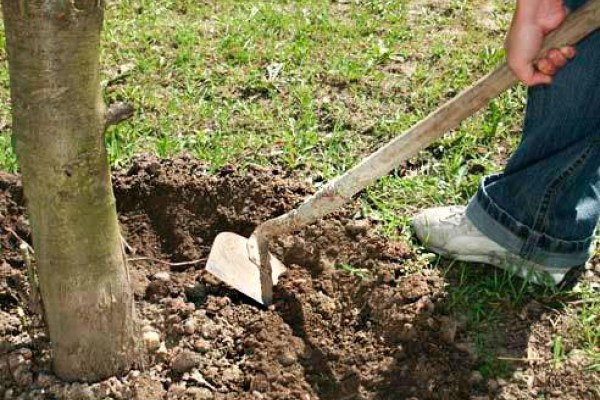
In spring, if the winter was wet, almost all trees, as a rule, do not need any additional watering. However, it should be understood that before flowering and after setting the fruits, the pear must be well moistened (provided with moisture).
In general, the pear should be watered not often, but abundantly.
Important clarification! At a young age (before the beginning of fruiting), a pear requires a particularly large amount of moisture (while the root is taproot), while in the process of further growth and development (the root system becomes branched), the tree, on the contrary, begins to react negatively to excess moisture (the roots can rot) ...
Video: how to water a pear
It is also very desirable to mulch the pear tree trunk circle. Thanks to the mulch, moisture will be better retained, it will not evaporate longer, and after watering it will not form a crust.
Peat, compost or humus are suitable as a mulching material, sawdust.
Only do not pour mulch close to the trunk: this can cause the bark to undergo.
Useful recommendation! Loose before watering and then mulch the tree circle.
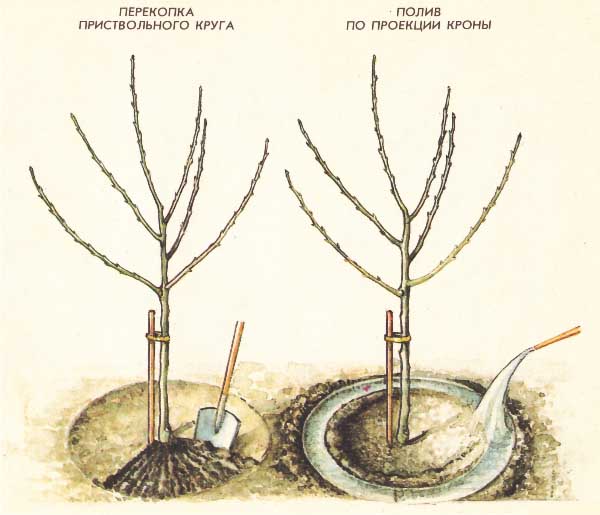
Top dressing
To restore the strength of the pear after winter, as well as for the tree to grow, it is necessary to carry out a comprehensive spring feeding of the culture.
Advice! Fertilizers are best applied into circular grooves 30-40 cm deep along the crown projection or into furrows.
In general, you can apply the standard scheme for feeding pears in spring and summer, which is suitable for all fruit trees:
- in early spring (it is possible even in the snow) - as a rule, they are used purely nitrogen fertilizers (optimally -ammonium nitrate) either complex nitrogen-phosphorus-potassium fertilizers (such as nitroammofosk), or their organic counterparts - infusion of mullein, bird droppings;
- before flowering - potassium-phosphorus fertilizers (more potassium);
- during flowering (under adverse weather conditions) - boron (foliar feeding);
- after flowering and the formation of ovaries - potassium-phosphorus (more potassium) + trace elements (magnesium, manganese, iron, calcium);
By the way! If you have already contributed phosphate fertilizers last year (autumn) then in the spring, before and after flowering, can be used only potash, for example, potassium sulfate or wood ash.
- after fruiting (in autumn) - phosphorus-potassium fertilizing (superphosphate + potassium sulfate or just potassium monophosphate).
Advice! All the information about how and what to fertilize pear trees in spring and summer, you'll find in this article about feeding an apple tree (for a pear, everything is the same, since both pome crops).
Video: feeding pears in spring
Treatment against diseases and pests
The pear is susceptible to many fungal diseases and pests. In order to prevent their development, it is necessary to timely carry out comprehensive protective and therapeutic treatments of the pear tree against diseases and pests in spring, summer and autumn.
The most annoying fungal diseases that affect the pear are:
- moniliosis or monilial rot (pears turn black and rot right on the tree);
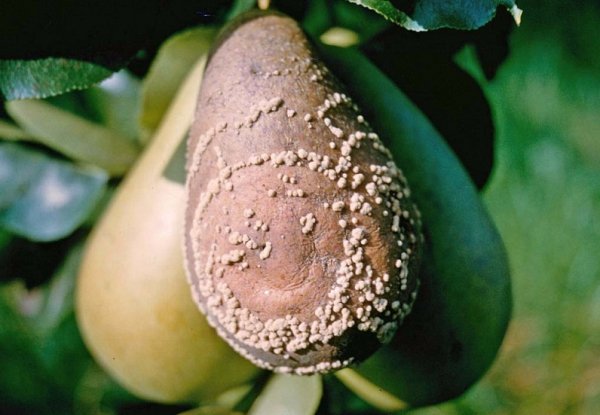
- scab;
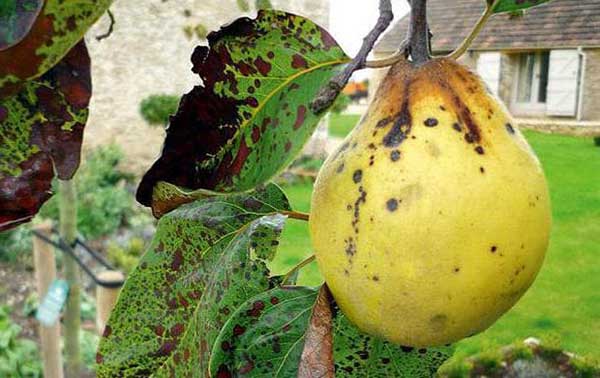
And the most dangerous infectious disease pears is fire blightwhich is very similar to monilial burn, but much more harmful. At the same time, the means of control are very limited, except that you can try using antibiotic solutions (streptomycin or oxytetracycline).
The pear is also attacked by pests (flower beetle, aphids, mites, copperhead, sawfly).
By the way! If your pear trees attacked by aphids, then in the fight against the malicious pest of fruit trees you will help this material.
To protect the pear from diseases and pests, you need to carry out several timely sprays:
- The first processing is carried out even on bare branches (trees), carrying out early spring eradication spraying.
- Then, several sprays are made at certain stages of culture development ("green cone", "pink bud", "pea-sized ovary").
By the way! The site contains detailed articles on how how to properly spray fruit trees (including pears) against diseases and pests in spring, and in the fall.
What else can you do in the spring in a pear garden
Graft
Experimental gardeners, as a rule, resort to this procedure in the following cases:
- A tree has grown from a bone (wild), and there is a need to plant a cultivar (varietal pear) on it.
- Not satisfied with a previously planted variety, and there is a desire to re-graft to a more suitable one.
- On one tree, you want to have several varieties at once.
By the way! The site already has an article about how to plant a pear, which disassembled all the main ways of grafting a fruit tree.
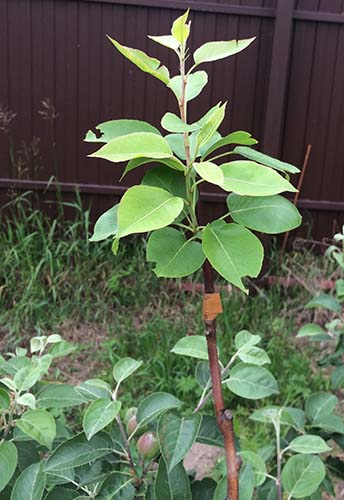
Advice! If the bark at the bottom of the trunk of your pear in winter is seriously damaged by rodents (mice or hares), so to speak, gnawed with a ring, then to save the tree, you canplant a pear with a bridge.
Transplant and landing
Of course, spring is a great time to start a new pear garden (planting a young seedling). You can also perform the transplanting procedure, for example, if the place turned out to be unsuitable, and you must definitely keep an earthen ball when you dig out the seedling.
And about that how to plant a pear in spring and autumn — read here.
Video: how to transplant a fruit tree correctly
As you understand, caring for a pear in spring is not so difficult at all: all activities are standard (except for bending the branches, which is relevant only for pears and partly for apple trees). But if you do everything correctly and in a timely manner, then the pear will delight you only with a tasty and large harvest.
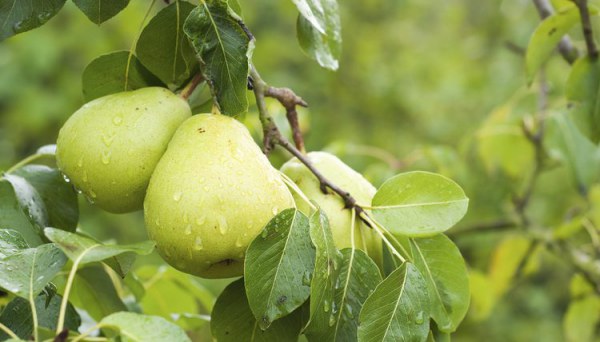


Good day. Our pear is about 15 years old, the branches wither along with the blossoming flower, what happened to the tree is not clear. What could it be?
Hello! It is very similar to moniliosis, or rather to monilial burn of pome fruits.
In this material, you will find illustrations of all stages of this disease on an apple tree (but for a pear, everything is the same, since both crops are pome crops).
https://villalux.desigusxpro.com/en/pochemu-yabloki-gniyut-pryamo-na-dereve-monilioz-prichiny-i-chto-delat/